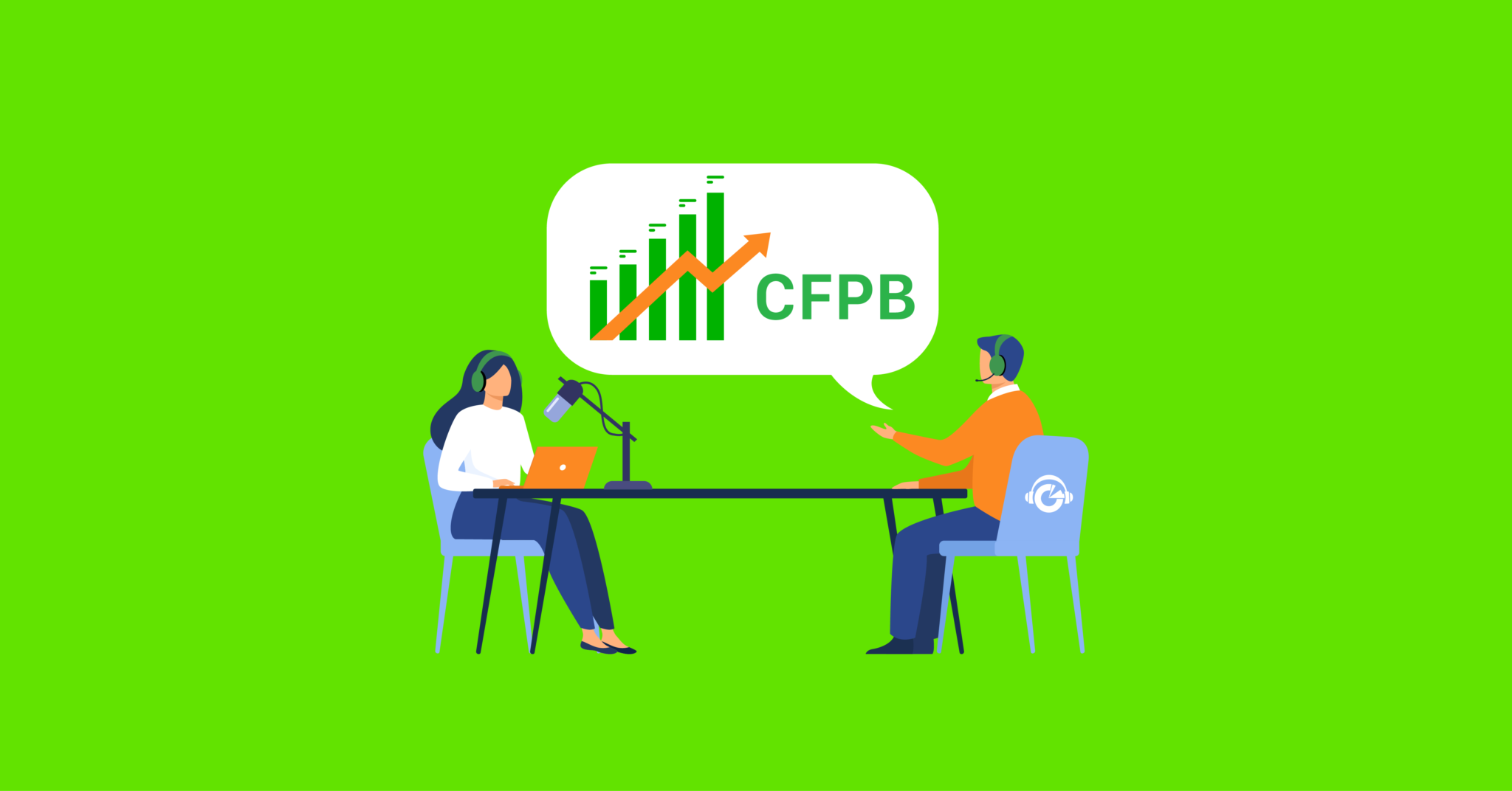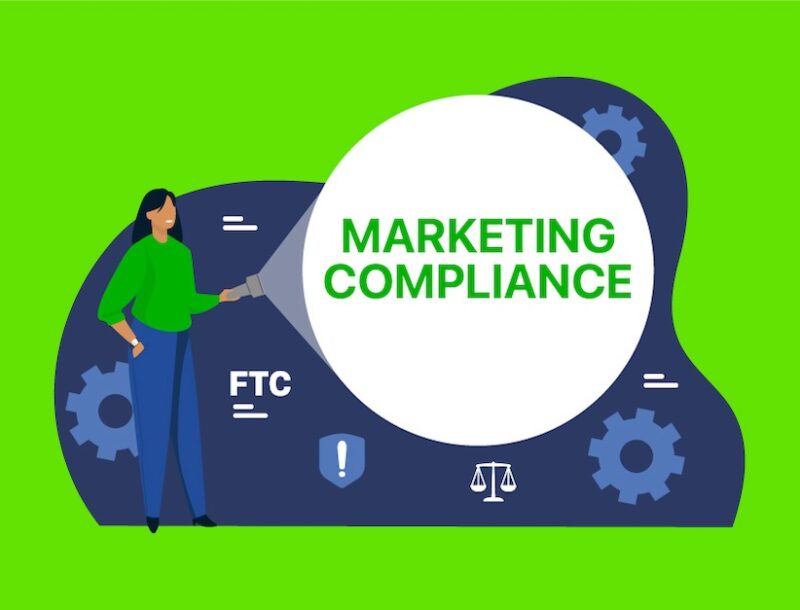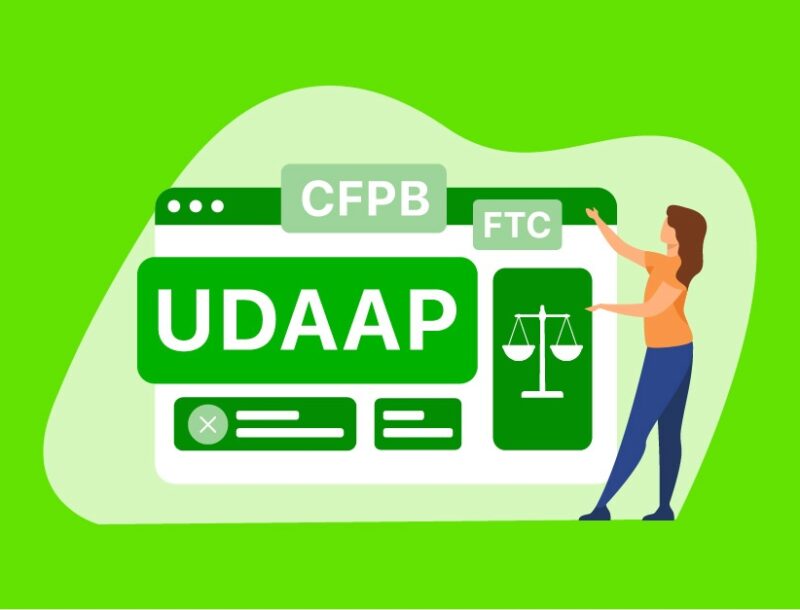Episode 16: CFPB Complaint Risk Signal Report Pt. 1

Episode Description:
This episode of the COMPLY Podcast is about one of our top annual content pieces—the CFPB Complaint Risk Signal Report. Every year we analyze the consumer complaints submitted to the Consumer Financial Protection Bureau and the compliance risk signals they present to financial institutions.
The CFPB uses this consumer complaint data to guide its supervisory and enforcement activities and today’s discussion focuses on:
- Big-picture complaint trends over the past year
- Increased complaints submitted by special groups
- Continued regulatory scrutiny on fair lending
- The latest happenings in the BNPL industry and expectations for this year
- Bank-fintech partnerships and the increasing importance of compliance
Show Notes:
- 2022 Complaint Risk Signal Report: https://bit.ly/3QkGOeY
- BNPL Regulation and Compliance at State and Federal Levels: https://bit.ly/3VPXIUf
- The Compliance Checklist for Bank-Fintech Partnerships and BaaS Providers: https://bit.ly/3idDIgy
- 16 Quick Tips for Proactive Fair Lending Compliance: https://bit.ly/3X7B7TZ
- Follow Rhonda: https://www.linkedin.com/in/rhonda-mcgill/
- Follow Gianna: https://www.linkedin.com/in/gianna-barrere/
Subscribe to COMPLY: The Marketing Compliance Podcast
About COMPLY: The Marketing Compliance Podcast
The state of marketing compliance and regulation is evolving faster than ever, especially for those in the consumer finance space. On the COMPLY podcast, we sit down with the biggest names in marketing, compliance, regulations, and innovation as they share their playbooks to help you take your compliance practice to the next level.
Episode Transcript:
Ashley:
Hey there, COMPLY podcast listeners, and welcome to 2023! We at PerformLine hope you all had a safe and healthy new year and are ready for a full year of killer marketing compliance content! We’re starting this season of our COMPLY podcast discussing one of our top annual content pieces – the CFPB Compliant Risk Signal Report. Every year we analyze the consumer complaints submitted to the Consumer Financial Protection Bureau and the compliance risk signals they present to financial institutions.
The CFPB uses this consumer complaint data to guide its supervisory and enforcement activities and today’s discussion focuses on big-picture complaint trends over the past year, increased complaints submitted by special groups, continued regulatory scrutiny on fair lending, the latest happenings in the BNPL industry and expectations for this year, and bank-fintech partnerships and the increasing importance of compliance
Thanks for listening and enjoy the show!
Gianna:
Hi, everyone. Thank you so much for joining us today. I’m Gianna Barrere, Content Marketing Manager here at PerformLine, and I’m joined by my colleague Rhonda McGill, Senior Director of Client Solutions. Rhonda, thanks so much for joining me today. I always love when we get to do these webinars together.
Rhonda:
Yes, I am so happy to be here with you again to discuss this most important annual report. This information just seems to get better and better and more in-depth each year, so I always look forward to it.
Gianna:
For sure. So before we jump in, I do wanna note that we will not have time for live Q&A today, but if you leave your question in the Q&A box, we will follow up with you after the event to get your questions answered. So today we’re gonna be taking a deep dive into the 2022 CFPB Complaint Risk Signal Report, which analyzes consumer complaints submitted to the CFPB to highlight key trends and compliance risks. PerformLine has published this report every year since 2015, and it’s our longest-running, and I would say, our most in-depth piece of content that we produce. It’s one of my favorite pieces to write each year, and it’s always so interesting for me to see how the data ties back into what the CFPB has done over the past year.
Gianna:
If you haven’t seen the report yet, we’ve linked a copy in the resources tab on your screen, and we will share a copy in our follow-up email once, we finish today. So this year’s report has almost 40 pages full of data, so there’s a lot to dig into today. But before we jump into the data, I did just wanna touch quickly on how the CFPB uses consumer complaint data and how organizations can use this data in their compliance programs. So the CFPB uses consumer complaint data to supervise companies and enforce regulatory compliance while identifying emerging issues. And according to the CFPB, there are a few different ways that organizations can use this complaint information. First, organizations can gain important knowledge about their business, competitors, and industry more broadly. Consumer complaints can be an indicator of potential risk management weaknesses or other deficiencies, such as violations of laws or regulations.
Gianna:
Complaints can reveal a weakness in a particular product, service, function, department, or vendor. And lastly, consumer complaints can help companies identify opportunities to enhance consumers’ experience and understanding of financial products and services. So with all that being said, 2021 was another record year of consumer complaints. But 2022 has already blown 2021 complaint counts out of the water. As of the end of November, there are almost 700,000 complaints in the CFPB’S database, a 54% increase from the same timeframe last year. And I also just wanna call out that this year’s complaint count is more than double the total number of complaints from 2019. So total complaint counts have been increasing almost exponentially year over year. So let’s talk about why there are so many complaints. Is this the aftermath of the pandemic? Is it the current state of the market and the economy? Are consumers just more aware of their ability to submit complaints to the CFPB? My guess is that it’s a combination of all of that, but Rhonda, I would love to hear your thoughts as well.
Rhonda:
I’m gonna say that I agree a hundred percent, that this is a combination of multiple things. So as we continue the discussion, I’m sure that many of those contributing factors are gonna start to become revealed.
Gianna:
For sure. So one key trend that we saw this year is that complaints from what the CFPB defines as special groups are up significantly, so military service members and older Americans. For the first time since 2018, complaints submitted by service members drastically increased up 64% in 2021, compared to 2020. And again, we’ve already surpassed that number for this year, up 45%. Complaints by older consumers has increased 43% in 2021, compared to 2020. And same thing, this is, you know, kind of the trend for 2022. We’ve already surpassed that number again, up about 10% from last year’s total complaint counts. So not as much of a drastic increase as military service members, but still increasing nonetheless. And these increases in complaints make sense given just the total volume of complaints submitted in this year alone. But Rhonda, what does this mean for, you know, companies who have customers who are service members or are considered older Americans?
Rhonda:
Yeah, I, you know, as I was reading your analysis on this, the CFPB has released several notices in response to the complaints that were logged by the military, specifically as it applies to credit reporting. So there’s a lot of aggressiveness apparently that’s going on with regards to unpaid medical bills that some of the military, you know, folks in that category, just thought were not right. And so there’s been some instances where there’s been some inaccuracies in billing. I would, I believe it was like 44% of the concerns of military personnel was around credit reporting. And then when you look at the older consumers, it seems that they have a bit of a wider range of concerns. Some of the things that were concerning to them were not just in the credit reporting, but also in the mortgage space, in the credit card space, bank accounts, and debt collection.
Rhonda:
So again, incorrect information was something that they were also concerned about. So I think this is just saying that there is an opportunity for the financial services industry to really focus in on these two groups and to really listen to their complaints and their concerns and address how to best service those concerns. You know, I would say following up on those complaints before they make it outside of your four walls is gonna be something that’s important. This is something that we’ve been able to do and work with our clients to do here at PerformLine because we’re able to monitor and, you know, certain key terms and phrases so that those are placed into an alert for our clients to really be able to address these things prior to them getting out of the four walls. So that makes a difference, it makes a huge difference. So our clients can put rules into place so that they’re able to identify these issues and follow up in a timely fashion and just make sure that the complaints or the concerns are being addressed. And again, it’s something that I think can be done, just by taking that extra step of monitoring.
Gianna:
Yeah, absolutely. It’s really just about, you know, knowing what those issues are and knowing what to monitor for, because that alone can, you know, eliminate probably so many compliance issues. Absolutely. You might run into. So let’s jump into some fair lending. So, fair lending has continued to be a focus for the CFPB over the last year. And they’ve taken, you know, several enforcement actions against mortgage companies for discrimination, updated the UDAAP examination manual to include discrimination as unfair and has been pretty vocal about their continued commitment to enforcing, you know, fair lending laws. So, safe to say, I think that, you know, fair lending will continue to be an important topic for 2023, but, you know, what’s next, and what should companies know?
Rhonda:
Fair lending doesn’t go away. I don’t think that, it’s something we talk about every year. And I really do believe that it’s gonna continue to be the focus, but we’re, as we’ve been looking just in the last few years, the CFPB, there’s been so many changes in that lending space. I mean, you think about the Buy Now, Pay Laters, the evolution of those, the fintechs and partnering with partner banks, the BaaS, the banking-as-a-service space, and now the mortgage space is even looking at creating more innovative ways to deliver mortgage products. Lending is always going to be front of mind from a regulator’s standpoint. So all of this is great for the market, it’s great for the consumer, but it also means that, you know, that extra competition in the market also has a lot of creativity that is going to require a little bit more of a regulator eye.
Rhonda:
So I don’t think that the regulatory space is gonna ease up. I think that they’re just gonna lean in and just really try to understand how all of these various, you know, competitors are set up, how they’re, you know, what are their risks, how are they impacting the consumers. And, you know, like here at PerformLine, as you know, we’re always deploying folks to conferences, we’re in trade groups, we’re on road shows, we’re talking to folks always and just trying to listen so that we can stay a few steps ahead for our clients and just making sure that we are a part of the conversation as the world of consumer finance continues to change.
Gianna:
Absolutely. And Rhonda, I remember you created kind of this content piece with your top 16 tips for fair lending compliance. Yeah, I think that’s a super awesome, you know, resource for our audience. So we will definitely share that with you all after this webinar. Ccheck it out, and it will definitely help you in 2023, with your fair lending efforts.
Rhonda:
Absolutely.
Gianna:
So the consumer’s use of buy now pay later products has boomed in recent years, and the CFPB has definitely taken notice, while the CFPB’S consumer complaint database does not yet have a designated category for these products. We did some digging and pulled out some insights using the consumer complaint narratives. So buy now, pay later related complaints have been steadily increasing since 2020 as the product’s popularity continues to rise. And as I’m sure everybody remembers, right around this time last year, the CFPB opened a market monitoring inquiry into buy now pay later credit, and issued a series of orders to five companies to gather information on the risks and benefits of the product for consumers. Then fast forward to this year, the Bureau issued their report in September summarizing this data and outlining some key areas of consumer risks. Rhonda, you did write a blog about this report when it first came out. Do you wanna kind of just touch quickly on your key takeaways from the report and what it means for buy now, pay later lenders?
Rhonda:
Yeah, I think that report, really kind of summed it up, and the report that the CFPB, when they submitted that report, they were very clear that they really focused on a few key, you know, key points including loan volumes by merchant industry and vertical. They spoke about revenue, expenses, and strategies, and policies for underwriting. There were some things that they did not take care of in that, in that initial reporting, because it was very, it had some limitations. And so I believe that there’s always the possibility that they’ll come back and wanna go a little bit deeper. The data that they provided, it was aggregated data, so it didn’t provide the in-depth individual loan level detail so that they couldn’t, so they couldn’t assess the credit performance from the data that they were collecting. So since they pretty much called out what they didn’t assess in the first go-round, I think you could pretty much read the writing on the wall, that if they do go back in, they’ll attempt to, close the gaps on the things that they didn’t do in that initial reporting.
Gianna:
Yeah, I totally agree. We actually just hosted a webinar a couple weeks ago with some experts from Ballard Spahr. Yeah, that goes more in-depth on the CFPB’S report, and you know, what it means for compliance from both a federal and a state level. So again, we will share the link to that recording once you wrap up here for anybody interested in hearing more. But again, safe to say, buy now, pay later will continue to be on the CFPB’s radar in 2023. And I’m really curious to see if they eventually add a, you know, buy now, pay later product type to their consumer complaint database so that we can easily, you know, look at those complaints and see what people…
Rhonda:
Are. It would be, I think it would be interesting. I know that one of the things that was revealed, they were talking about potentially utilizing the same regulatory oversight that they do with credit cards. Yeah., but I wonder, you know, is that gonna change? Is that going to be the case? And you know, it’ll be interesting to see how they categorize and if they kind of parse out the buy now, pay later space.
Gianna:
Yeah, absolutely. But, only time will tell.
Rhonda:
For sure. We’ll see what happens for sure.
Gianna:
So, let’s jump into the fintech and partner bank space briefly. So between January and October of this year, there are already over 11,000 complaints against fintechs and partner banks in the CFPB’s database. And one big update that the CFPB made this year is that they invoked a dormant authority to examine non-bank companies posing risks to consumers and has begun focusing on bank-fintech partnerships, and relationships from a consumer protection perspective. And not only the CFPB has ramped up their supervision, but you know, the OCC has as well. So, you know, with all of this, what do you think we can expect in 2023 for fintechs and partner banks and even, you know, the banking-as-a-service providers that they work with?
Rhonda:
Yeah, you know, just like I was saying a few minutes ago when we were talking about fair lending and then in that space, you know, this is an area that’s ever-changing. Just before the holiday, the Treasury Department released a report in response to the July 2021 executive order by President Biden, to assess the impact of new entrant non-bank firms on competition and consumer finance markets. So the report just took a deep dive into how non-bank and fintechs are affecting competition with the depository banks. So I will say, just keeping in mind the treasury and what they are looking at is a little bit different from how the CFPB is going to look at, you know, the non-bank space. So it’ll be interesting to see how the CFPB approaches, based on what they’ve learned from the treasury report, and how they’re going to approach the fintechs and the partner banks and the BaaS as they continue to grow. Because BaaS is really starting to overtake because they’re able to kind of almost kind of come in and be a little bit more of a middleman between the, you know, the fintech and the partner banks.
Rhonda:
So there’s so much, so much change, that’s ever-changing. I think it’s just one of those we have to continue to stay close to and really watch.
Gianna:
Yeah, for sure. And, I really, you know, we’ve been saying this for a while now, but that, you know, kind of industry is really gonna, I think, boom in the next year.
Rhonda:
Oh, absolutely. I mean…
Gianna:
It already has
Rhonda:
It can help a small business to grow like that. So yes, a BaaS has every opportunity to really, really help catapult a business to be able to do a lot more than what it would be able to do if it was just focusing within its own, you know, its own current circle. So yes, there’s a lot more access for the small business by utilizing the BaaS services. So yeah, I think BaaS is definitely taking off, and it’s gonna do a lot in the coming years.
Gianna:
Yeah, for sure. And for, you know, BaaS providers and fintechs and the partner banks having kind of that compliance program in place will be super beneficial to them as they’re, you know, growing and, and trying to acquire more, you know, partners or customers or, you know, so be it. So it’ll definitely be interesting to see how that shakes out.
Rhonda:
Absolutely. I think I would definitely say one of the things I’ve been listening to is folks, kind of in that, in that fintech space saying, oh yeah, the BaaS really makes it a lot easier cuz we can kind of pull back a little bit from the compliance side because they take care of it. And I’m like, oh yeah, every time we say we’re gonna pull back from compliance, there’s always something that brings us back to it. So, I would definitely say it’s one that we need to watch and figure out how, from a regulator standpoint that they’re gonna work with, you know, enforcing any type of compliance.
Ashley:
Thanks for listening to this episode of the COMPLY podcast! It should probably go without saying that if you haven’t had a chance to read our CFPB Compliant Risk Signal Report, we recommend that you do so. It’s full of all the stats discussed during today’s episode and it’s available in the show notes. We also have several resources that pertain to the regulations the industries talked about during today’s episode – for those be sure to check out today’s show notes and as always for the latest content on all things marketing compliance you can head to content.performline.com.
Thanks again for listening and we’ll see you next time!


